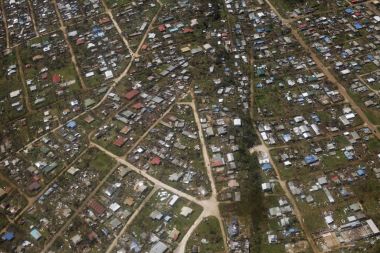Aid agencies fly in to cyclone-hit Vanuatu islands, find scenes of 'total devastation'

International aid agencies have begun emergency flights to some of the remote outer islands of Vanuatu, which they fear have been devastated by a monster cyclone that tore through the South Pacific island nation.
Disaster management officials and relief workers are still battling to get rescue teams on to many of the islands that bore the brunt of Cyclone Pam's winds of more than 300 kph (185 mph) on Friday and Saturday.
The United Nations said the official death toll from the cyclone was 11, revising down its earlier figure of 24, but many officials anticipate that number will rise once they are able to more thoroughly inspect the outer islands of the scattered archipelago.
Some 3,300 people were left homeless after the category 5 storm destroyed homes, flattened buildings and washed away roads.
Helicopters are being used to land on higher ground on the islands after planes from Australia and New Zealand assessed the damage from the air but were unable to land in remote areas because of flooding.
"The aerial reconnaissance flights confirmed significant damage in the southern islands, particularly Tanna island, where it appears that more than 80 per cent of houses and buildings have been partially or completely destroyed," Australian Foreign Minister Julie Bishop told reporters in Canberra.
A Reuters witness on Tanna, an island of 29,000 people about 200 km (125 miles) south of the capital, said the scene around the airport was of "total devastation", with every shred of green stripped from the trees.
Red Cross aid worker Peter Lawther said schools and concrete homes across Tanna had been destroyed.
"Shelter, along with water and food, remains a top priority, and we are working on getting help here as quickly as possible," Lawther said.
Reports from aid groups also said the main town on the island of Erromango, north of Tanna, had suffered similar destruction.
FOOD SCARCE
In the capital of Port Vila, the clean-up was beginning, but there were worries about food scarcity and healthcare after the main local food market was destroyed and the city's hospital severely damaged.
Bishop said Australia was sending a 20-strong emergency medical assistance team made up of doctors, nurses, paramedics and a pharmacist. They plan to set up a temporary ward in the car park of the damaged Port Vila hospital capable of treating up to 40 patients.
The majority of locals rely on foods sold at the downtown market such as taro, island cabbage, bananas, kumara and yams for their staple diet.
Shops selling tinned food were open and stocked in the capital, but most locals do not have the money to buy those foods and many were reported scavenging for bananas or fruit.
A 6 pm to 6 am curfew has been imposed to prevent looting, while long queues formed at petrol stations.
"We have water, but the situation is very bad because people don't have local food," shop owner Colette Calvo said. "All they can eat is food like bananas that they pick up off the ground and they can get sick."
Australia, which has already sent five planes with personnel and humanitarian supplies, dispatched another three planes on Tuesday. It also began loading up its emergency response ship HMAS Tobruk, which is capable of driving up onto beaches, for possible deployment.
TOURISTS LEAVING
Formerly known as the New Hebrides, Vanuatu is a sprawling cluster of more than 80 islands and 260,000 people, 2,000 km (1,250 miles) northeast of the Australian city of Brisbane.
Perched on the geologically active "Ring of Fire", Vanuatu, one of the world's poorest nations, suffers from frequent earthquakes and tsunamis and has several active volcanoes, in addition to threats from storms and rising sea levels.
The Asian Development Bank (ADB) had a team of engineers in Vanuatu before the cyclone struck, finalising plans for sanitation works, road rehabilitation and port development.
As well as a contributing an emergency A$5 million disaster relief package, the agency was working to speed up those existing projects.
"It was good coincidence," Andrea Iffland, the regional director of ADB's Pacific Liaison and Coordination Office in Sydney. "Quite a lot of preparation work has already been done; subject to the availability of contractors, we hope to really expedite it."
Aid from New Zealand, France and the United States also continued to be flown in as most foreign tourists headed out.
Tourism, which accounts for about 40 per cent of Vanuatu's economy, has been badly affected, with Port Vila closed to cruise liners indefinitely.
"We are keen to go back as soon as possible, given how important this industry is to the Vanuatu economy, but we won't go back until the authorities give us the all clear," said David Gray, a spokesman for the Australian arm of cruise company Carnival Corp.
Almost 200 people, most of whom were Australian tourists or workers, were evacuated on two Australian military flights. Australia had another plane on standby on Tuesday to evacuate the elderly, the sick, pregnant women and children.
Aid officials said the storm was comparable in strength to Typhoon Haiyan, which hit the Philippines in 2013 and killed more than 6,000 people.











